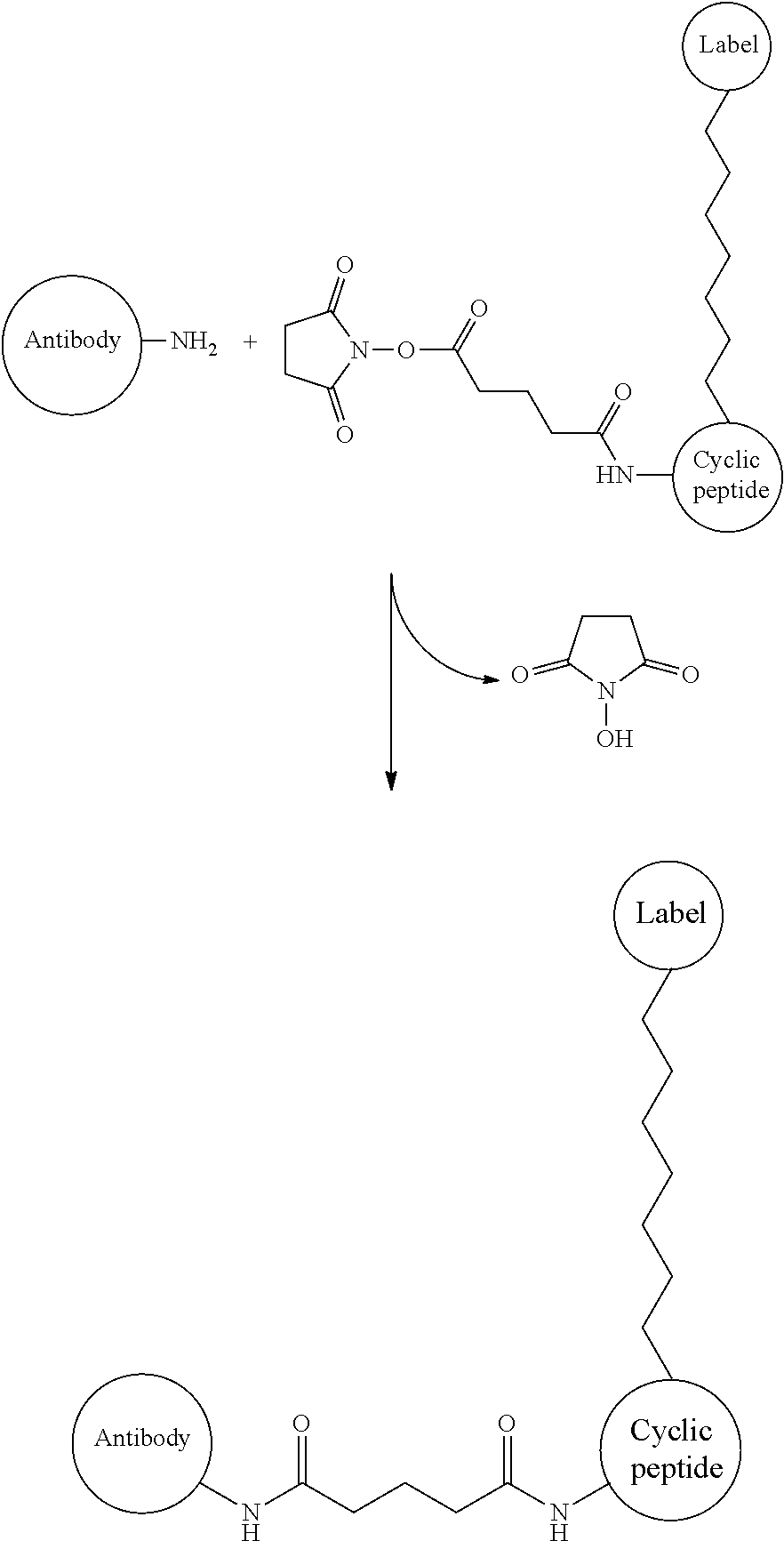Cyclic peptide, affinity chromatography support, labeled antibody, antibody drug conjugate, and pharmaceutical preparation
a technology of affinity chromatography and labeling antibodies, which is applied in the field of cyclic peptides, affinity chromatography support, labeled antibodies, and antibody drug conjugates, can solve the problems of increasing the cost of the protein column used for the purification of pharmaceutical products, and achieve excellent antibody binding properties and improve chemical resistan
- Summary
- Abstract
- Description
- Claims
- Application Information
AI Technical Summary
Benefits of technology
Problems solved by technology
Method used
Image
Examples
example 1
[0340](1) Synthesis of Cyclic Peptide
[0341]A cyclic polypeptide (SEQ ID NO: 3) represented by Formula (3) was synthesized using a full automatic peptide synthesis device (PSSM-8, manufactured by Shimadzu Corporation). Hereinafter, this cyclic peptide will be referred to as “cyclic peptide 1” in some cases.
Asp-[Lys(N3)]-Ala-Tyr-His-Arg-Gly-Glu-Leu-Val-Trp-[Bpg]-Thr-Lys-Lys (3)
In Formula (3), [Lys(N3)] represents an amino acid residue derived from ε-azide-L-lysine, [Bpg] represents an amino acid residue derived from L-bishomopropargylglycine, and [Lys(N3)] and [Bpg] are cross-linked to each other through a triazole bond formed by a cycloaddition reaction between a side-chain azide group and a side-chain ethynyl group (see the following chemical formula).
[0342]In the above chemical formula, “*” represents a point of binding to an adjacent amino acid residue.
[0343](2) Ligand Immobilization
[0344]A commercially available CM5 (carboxymethyl dextran introduction-type, manufactured by GE He...
example 2
[0379](1) Based on Example 1, a cyclic peptide (SEQ ID NO: 4) represented by Formula (4) was synthesized. Hereinafter, this cyclic peptide will be referred to as “cyclic peptide 2” in some cases.
Asp-[Lys(N3)]-Ala-Tyr-His-Leu-Gly-Glu-Leu-Val-Trp-[Bpg]-Thr-Lys-Lys (4)
[0380]In Formula (4), [Lys(N3)] represents an amino acid residue derived from ε-azide-L-lysine, [Bpg] represents an amino acid residue derived from L-bishomopropargylglycine, and [Lys(N3)] and [Bpg] are cross-linked to each other through a triazole bond formed by a cycloaddition reaction between a side-chain azide group and a side-chain ethynyl group (see the following chemical formula).
[0381]In the above chemical formula, “*” represents a point of binding to an adjacent amino acid residue.
[0382](2) An immobilized sensor chip B was obtained in the same manner as in Example 1, except that the cyclic peptide 2 was used instead of the cyclic peptide 1.
[0383](3) The binding activity was evaluated in the same manner as in Exa...
example 3
[0387](1) Based on Example 1, a cyclic peptide (SEQ ID NO: 5) represented by Formula (5) was synthesized. Hereinafter, this cyclic peptide will be referred to as “cyclic peptide 3” in some cases.
Asp-[Bpg]-Ala-Tyr-His-Leu-Gly-Glu-Leu-Val-Trp-[Lys(N3)]-Thr-Lys-Lys (5)
[0388]In Formula (5), [Bpg] represents an amino acid residue derived from L-bishomopropargylglycine, [Lys(N3)] represents an amino acid residue derived from ε-azide-L-lysine, and [Bpg] and [Lys(N3)] are cross-linked to each other through a triazole bond formed by a cycloaddition reaction between a side-chain ethynyl group and a side-chain azide group.
[0389](2) An immobilized sensor chip C was obtained in the same manner as in Example 1, except that the cyclic peptide 3 was used instead of the cyclic peptide 1.
[0390](3) The binding activity was evaluated in the same manner as in Example 1. The evaluation results are shown in the column of “Relative binding activity” in Table 3.
[0391](4) An immobilized support C was obtain...
PUM
| Property | Measurement | Unit |
|---|---|---|
| affinity | aaaaa | aaaaa |
| chemical resistance | aaaaa | aaaaa |
Abstract
Description
Claims
Application Information
 Login to View More
Login to View More - R&D
- Intellectual Property
- Life Sciences
- Materials
- Tech Scout
- Unparalleled Data Quality
- Higher Quality Content
- 60% Fewer Hallucinations
Browse by: Latest US Patents, China's latest patents, Technical Efficacy Thesaurus, Application Domain, Technology Topic, Popular Technical Reports.
© 2025 PatSnap. All rights reserved.Legal|Privacy policy|Modern Slavery Act Transparency Statement|Sitemap|About US| Contact US: help@patsnap.com



